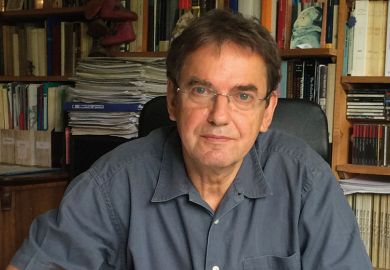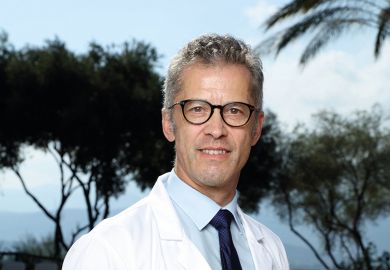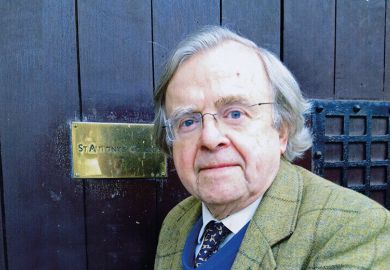Alan Cooper is director of the Australian Centre for Ancient DNA at the University of Adelaide. He was previously professor of ancient biomolecules at the University of Oxford. In 2016, he was named South Australian Scientist of the Year, and last year he won a Eureka prize for a project that constructed a map of pre-European indigenous Australia, based on DNA analyses of decades-old Aboriginal hair samples.
Where and when were you born?
I was born in 1966 in Dunedin, in New Zealand, and grew up in Wellington.
How has this shaped you?
Wellington is nicely situated between caving districts. Caving was my early passion. My speciality was digging out rockfalls. I often used to end up using bones of the giant moa bird, which you find everywhere in the caves of New Zealand. The leg bone of a big moa is about a metre long. They’re fantastic crowbars, which, in retrospect, was about as sacrilegious as you could possibly be. That’s what eventually got me into working on the animals themselves – the genetics of the moa, which was the subject of my PhD.
Is caving a metaphor for your field?
Ancient DNA is constant discovery. You never know where it’s going to go. We often joke about it being science without a hypothesis. Stuff we can measure today might give you an indication of, for example, human genetics and how we got here. No one is going to guess that that involved interbreeding with Neanderthals and Denisovans, and that we’ve all changed our make-up because of recent dietary changes. Ancient DNA is full of bizarre results that you then try to fit into context. That’s very much like caving. You can’t see it until you explore underground.
Have you had a eureka moment?
In ancient DNA, you get them all the time. Eureka moments are when you really don’t have a clue what you’re doing, and you’re struggling to make sense of quite unorganised data. A recent one was when we mapped the genetic diversity of Aboriginal populations around Australia. We expected it would be evenly distributed, with slight differences here and there. We saw quite the opposite. The genetics were unique in different parts of the country. We thought, how could this happen? It suddenly resolved itself into a picture that revealed the original colonisation of Australia 50,000 years ago, around the west and east coasts in parallel, eventually meeting west of Adelaide. The genetics still show that pattern. Suddenly you’re looking 50,000 years into the past. You couldn’t do that anywhere else in the world.
Do such insights have practical applications?
We see the nature of genetic diversity change very dramatically, multiple times through recent history, and those changes underpin where we are today. For example, when humans switched over from hunting and gathering to [farming and eating] grains, the genetics to do with things such as insulin and fat metabolism changed a whole bunch at that point. These are the very genetic systems that we now see cropping up in diabetes and heart disease. Understanding how it came about gives us a clue as to the sorts of treatments you might apply. Looking back through time, when one set of genetic changes goes off, you often get a suite of changes as related pathways adjust. So you can relate differing pathways that might otherwise be unconnected. Quite often you recognise certain genes coming up where there’s already an existing drug.
What fieldwork really stands out for you?
Ancient DNA tends to survive under cold conditions – Russia, Yukon, Tierra del Fuego. Two years ago, four of us were stuck in a tent in the middle of the West Antarctic ice sheet.
How did Madagascar’s giant, extinct elephant bird convince you that New Zealand’s kiwi had once been able to fly?
For years, scientists thought that ratites – including the ostrich, emu, kiwi, South America’s rhea and numerous extinct species – had been walking around the ancient continent of Gondwana and had become separated as it broke apart. I spent about 25 years researching how this could possibly work. Finally, we analysed DNA from the elephant bird and found that it was the kiwi’s closest relative. There’s no way you could explain that by walking. They had to have flown. Even though they don’t look like anything that could fly, clearly they must have done so if those two birds were each other’s closest relatives.
Tell us about someone you’ve always admired.
Alan Wilson, a Kiwi who started getting interested in the moa. He set up the field of ancient DNA, using genetics to study evolution.
What’s changed most in higher education in the past 10 to 15 years?
I’ve noticed a real drop-off in the number of people interested in graduate studies. Back in my day, there was a lot more passion for knowledge, and the discovery of knowledge as being exciting enough to justify itself. I wonder if having so much knowledge and entertainment at the fingertips, through the web, has changed people’s reward from doing it themselves.
What advice would you give postgraduate students considering your field?
It attracts those who can handle chaos. Those who have a rigorous background, and want everything defined beforehand, find it a bit challenging. There’s an interesting relationship between human personality patterns and the type of science people get into.
If you were higher education minister for a day, what would you change?
The grant application structure. I like the New Zealand system, where they ask for grant applications of only four or five pages, do a quick 50 per cent cut and then ask only those who get through to write full applications. In Australia, researchers spend a good 15 per cent of their time each year writing grant applications, when success rates are only about 20 per cent. That’s a huge investment for a very small return.
What’s your most memorable moment from university?
We used to go out in the evenings climbing the outsides of the buildings, because we were in the caving club. In retrospect, it would not be entirely encouraged by the authorities. But it was great fun at the time.
john.ross@timeshighereducation.com
Appointments
Koen Lamberts, the vice-chancellor of the University of York, is to take on the same job at the University of Sheffield. Professor Lamberts will start at Sheffield in November, after Sir Keith Burnett retires at the end of September. The cognitive psychologist, who was formerly deputy vice-chancellor of the University of Warwick, has led York since 2014. Professor Lamberts, who was born and educated in Belgium, said that he felt “enormously privileged” to join the university. “Sheffield is known across the world for the excellence, impact and distinctiveness of its research and teaching, and for being a university which speaks fearlessly for the value of international scholarship to transform lives for the better,” Professor Lamberts said.
Alex Zelinsky will be the next vice-chancellor of Australia’s University of Newcastle. Dr Zelinsky, who has been Australia’s chief defence scientist since 2012, will start in November. The computer scientist has served as group executive of information sciences at the Commonwealth Scientific and Industrial Research Organisation and has held academic and research leadership roles at the Australian National University. “Dr Zelinsky has the rare combination of experience in research, education, industry and start-ups,” said Newcastle’s chancellor, Paul Jeans.
Tracey Reeves has been named assistant vice-president for institute news and campus communications at the Georgia Institute of Technology. Once a Washington Post reporter, she has been director of media relations at Johns Hopkins University for a decade.
Tim Fenton, the former BBC News Online managing editor, will become director of journalism at the University of Essex. Mr Fenton, who joined the university in 2016, will lead the subject from September.
John Brumby, the former Victoria premier, is to become chancellor of La Trobe University. Mr Brumby, who led the Australian state from 2007 to 2010, will take on the role in March 2019.
Register to continue
Why register?
- Registration is free and only takes a moment
- Once registered, you can read 3 articles a month
- Sign up for our newsletter
Subscribe
Or subscribe for unlimited access to:
- Unlimited access to news, views, insights & reviews
- Digital editions
- Digital access to THE’s university and college rankings analysis
Already registered or a current subscriber?




